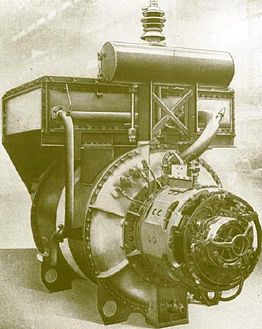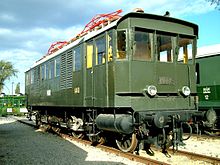Rotary phase converter
| It has been suggested that this article be merged into Phase converter. (Discuss) Proposed since May 2012. |
This article has multiple issues. Please help improve it or discuss these issues on the talk page.
|
A rotary phase converter, abbreviated RPC, is an electrical machine that produces three-phase electric power from single-phase electric power. This allows three phase loads to run using generator or utility-supplied single-phase electric power.
Contents
[hide]The original "Kandó" design of phase converter[edit]
At the beginning of the 20th century there were two main principles of electric railway traction current systems:
- DC system
- 16 2/3 Hz three phase system
All of them needed a separated supply system or converters to the standard 50Hz electric network. Kálmán Kandó recognized that the electric traction system must be supplied by single phase 50Hz power from the standard electric network, and it must be converted in the locomotive to 3 phase power for traction motors. He created an electric machine called phase converter. It was a single phase synchronous motor and a three phase synchronous generator with common stator and rotor. It had two independent windings. The winding placed closer to the rotor is a three phase (or variable phase) synchronous generator, the other is a winding of a single phasesynchronous motor. The winding of the motor takes the power from the overhead line and the generator provides the power for the three (or more) phase traction motors.
Types[edit]
A rotary phase converter (RPC) may be built as a motor-generator set. These completely isolate the load from the single-phase supply and produce balanced three-phase output. However, due to weight, cost, and efficiency concerns, most RPCs are not built this way.
Instead, they are built out of a three-phase induction motor or generator, called an idler, on which two of the terminals (the idler inputs) are powered from the single phase line. Therotating flux in the motor produces a voltage on the third terminal. A voltage is induced in the third terminal that is shifted by 120° from the voltage between the first two terminals. In a three-winding motor, two of the windings are acting as a motor, and the third winding is acting as a generator.
Power quality[edit]
A common measure of the quality of the power produced by an RPC or any phase converter is the voltage balance, which may be measured while the RPC is driving a balanced load such as a three-phase motor. Other quality measures include the harmonic content of the power produced and the power factor of the RPC motor combination as seen by the utility. Selection of the best phase converter for any application depends on the sensitivity of the load to these factors. Three-phase induction motors are very sensitive to voltage imbalances.
The quality of three-phase power generated by such a phase converter depends upon a number of factors including:
- Power capacity of the phase converter (idler horsepower rating).
- Power level demands of the equipment being supplied. For instance, "hard starting" loads such as heavily loaded machinery or well pumps may have higher requirements than other loads rated at the same horsepower.
- Power quality demands of the equipment being supplied (CNC equipment may have more stringent power quality requirements than a welding machine)
- Use of techniques to balance the voltage between the three legs.
Quality improvement[edit]
RPC manufacturers use a variety of techniques to deal with these problems. Some of the techniques include,
- The insertion of capacitors between the terminals to balance the power at a particular load.
- The use of idlers with higher power ratings than the loads.
- The construction of special idler motors with more windings on the third terminal to boost the voltage and compensate for the sag caused by the load.
- The use of electronics to switch in capacitors, during start up or otherwise, based on the load.
- The use of filters.
How RPCs work[edit]
The main principles of RPC operation are as follows: Three-phase induction motors have three terminals called "legs", usually numbered (arbitrarily) L1, L2, and L3. A three-phase induction motor can be run at two-thirds of its rated horsepower on single-phase power applied to any pair of legs, once spun up by some means. A three-phase induction motor that is spinning under single-phase power applied to legs L1 and L2, generates an electric potential (and can deliver power through) leg L3, although without some form of current injection, special windings in the idler, or other means the voltage will sag when a load is applied. Power factor correction is a very important consideration when building or choosing an RPC. This is desirable because an RPC that has power factor correction will consume less current from the single-phase service supplying power to the phase converter and its loads. Balanced voltage between the three legs of power is important for operational life of the equipment receiving that power. Unbalanced three-phase power can damage the equipment that it is meant to operate.
Use of RPCs[edit]
General[edit]
RPCs may be used anywhere three-phase devices need to be used, but only single phase power is available. Three-phase motors cannot start on single phase power without a device to generate three-phase power. Since prices (and quality) of used three-phase motors are usually more favorable than those of their single-phase counterparts, demand exists for phase converters. This is also true because single-phase electric motors generally are not available in sizes over 15 hp (11 kW) due to their complexity, starting requirements and relative high expense and low efficiency compared to three-phase motors. In fact, single-phase motors larger than 5 hp (3.7 kW), though available, are rarely seen in use for these reasons. RPCs are sold by various vendors, but often also are home made.
Electric railways[edit]
Rotary phase converters are used in the opposite direction (three-phase to single-phase) for electric railways. In Europe, electricity is normally generated as three-phase AC at 50 Hertz. Five European countries, Germany, Austria, Switzerland, Norway and Sweden have standardised on single-phase AC at 15 kV 16⅔ Hz for railway electrification. Phase converters are, therefore, used to change both the phase and the frequency.
Alternatives to rotary converters[edit]
Alternatives exist to rotary phase converters for operation of three-phase equipment on a single-phase power supply.
- Static phase converters are actually not a converter at all. They start the motor spinning and then "single-phase" the motor. They also require de-rating of the motor being run, typically to 60% or less of its three-phase rating. A 10 hp (7.5 kW) motor can be run only at 6 hp (4.5 kW). The power balance and thus motor efficiency is extremely poor. Failure to run a motor at reduced load will result in overheating and quite often destruction of the motor. Many machine manufacturers and dealers specifically state that the use of a static converter will render any warranty null and void.
- Three phase inverters and related variable frequency drives, may, under certain circumstances, produce large amounts of harmonic distortion in their output, and the efficiency of the inverter-motor combination can be poor. When poor efficiency in a VFD powered motor has been investigated, in every case documented to date, the root cause for the loss in efficiency was either improper installation or a failure to adhere to best practices. Almost universally, a VFD increases the efficiency of a system and reduces operating costs.
- Inverter drives (VFDs)can damage some motors not rated for use with an inverter but this is not a concern when motor voltages are less than 440 VAC. Motor manufacturers may void warranties on non-inverter rated motors if they are run at a variable speed or with an inverter, but most three phase motors over 10 hp (7.5 kW) sold today are rated for use with an inverter drive. This damage can be prevented by the use of load and line reactors or in Europe a DU/DT filter. This reactor or filter reduces the voltage stack up that can occur on older high impedance motors such as wound rotor motors. The filter prevents the windings of the motor form insulation breakdown caused by voltage stack up.
- VFDs that have a capacity greater than 3 hp can be costly thus making the RPC an attractive option.





No comments:
Post a Comment